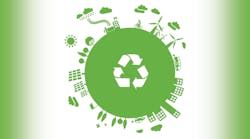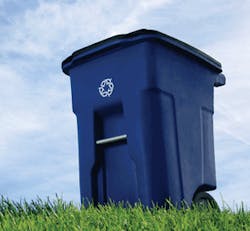Just saying landfill might earn you a stern look from some people—if not the threat of the old "soap in the mouth" treatment.
There was a time when landfills served an important role in waste disposal. In fact, landfills were, in a manner of speaking, the "final resting place" for trash. From broken TVs to dead car batteries, from cardboard boxes to plastic wrap, from aluminum cans to paper, products—seemingly at the end of their useful lives—ended up in landfills.
See Also: Supply Chain Technology & Automation Trends
But environmental and safety concerns, reinforced by federal guidelines established in the 1970s, put the spotlight on proper waste disposal—and on the rebirth of recycling.
Although there's evidence to suggest that its origins trace back thousands of years, recycling is generally viewed as the linchpin of the environmental movement of the late 1960s and early '70s, spawning greater public awareness of the benefits to reduce, reuse and recycle.
These benefits still resonate today, as private citizens and companies alike face a choice of whether to recycle or simply discard an item. On a corporate level, many companies are increasingly looking to be more cost efficient while reducing their carbon footprint.
But when crossing the altruism of recycling with the hard realities of the bottom line, what's the best approach?
Managing Returns
In the late 1980s product returns management underwent a transformation, leading to the centralized returns process known today as "reverse logistics." Like many great ideas, this came about because of a simple request for help.
A company in the retail discount drug business was being overwhelmed with store returns and needed somewhere to put them.
In addition to a glut of returns that were accumulating quickly, this company lacked a reliable software package to process them.
Herb Shear, executive chairman of GENCO and grandson of the company's founder, worked with this company to develop a software package to scan the returns, identify the product and the store it came from so the store could get inventory credit, and then, where possible, charge back suppliers for these items. Thus, an integral—and profitable—segment of companies' supply chains was born.
Hello Again, Recycling
Another revolution, one that has a natural tie-in to reverse logistics functions, is underway today.
Call it "old school" or "retro," recycling is . . . well, it's not back, because it never really left. It has changed with the times, though. Still rooted in the important fundamental of separating trash, recycling has, in a way, repackaged itself. An environmentally friendly strategy for disposing of waste, a comprehensive recycling program gives companies new uses for end-of-life products, compliance with federal and local laws, and a much-needed additional revenue stream.
There's one more benefit: a leaner, greener supply chain.
It Sounds Like a Good Idea, But, . . .
Companies traditionally treat returns as basically a "zero-sum" necessary part of doing business. Little wiggle room exists for the disposition of these products: It's either return to vendor or liquidation.
Oh, and the landfill still tempts some.
However, not everything can be resold on the secondary market or sent back to vendors.
And the landfill should be the last option.
Recycling's appeal has many layers—environmentally sound, the right thing to do, competitively smart. For as many reasons, though, that companies are inclined to start a recycling program, one or two barriers can upset these plans.
What can be recycled? I don't know what happens to my waste stream. Are there a lot of regulatory issues to muddle through? If we have a recycling program, doesn't that take my employees away from their jobs, and isn't there a risk of injury? What return on investment can I expect? We have a small recycling program, but the local hauler takes the stuff, and we never know how much is recycled. We have a bunch of old computers that are no good anymore, but don't know the best way to get rid of them.
Managing the components of a comprehensive, compliant recycling program can be a struggle for companies because of challenges just like these.
Getting Help
One answer can be to work with third-party firms that have not only expertise in the returns business but also knowledge of the nuances of an effective recycling program. They will:
➤ Analyze the waste stream—what can be recycled, what can be resold, what can be remanufactured—and determine the correct disposition.
➤ Establish relationships with downstream partners, such as haulers, local recyclers and sorters that can be trusted.
➤ Supply visibility to data and reporting so companies know how much trash they're generating and where it's ending up, and have a reliable tracking mechanism.
➤ Ensure compliance with regulatory agencies.
➤ Generate the best recovery possible.
What's Your Waste Stream Doing?
Depending on whom you ask, there are either a thousand or 8 million stories in the naked city. As with most honorable disputes, the truth is probably somewhere in the middle.
Without data, the waste could be going anywhere. What about the waste itself—can you identify/quantify the trash you're producing?
The answer—and the starting point for any successful recycling program—is in the waste stream. The waste stream contains valuable information that must be validated to develop the appropriate recycling solution for a company.
So, what can be recycled? It's more like, what can't be recycled? Recyclable products run the gamut, from office paper, corrugate and plastics, to metals, wood and stretch wrap. Even excess and obsolete inventory that's been gathering dust can be recycled.
Companies that opt to develop and maintain their own recycling programs are learning some difficult lessons—whether receiving incomplete or inaccurate data from the firms doing their recycling, absorbing prohibitive transportation costs, seeing a low recovery or failing to meet regulatory standards.
Having a third party manage the recycling program eliminates guesswork and addresses the issues. This includes vetting all downstream partners to ensure reliability and maximize recovery, weighing fluctuating transportation costs, the labor needed for the program, the regulatory landscape and other factors.
The result is a regulatory-compliant disposition solution that:
➤ Mitigates waste management costs;
➤ Provides data security;
➤ Eliminates landfill fees; and
➤ Maximizes the recovery value of existing waste streams.
Make Recycling Make Sense
Bottom-line priorities and achievements can come at a price, as customers and stakeholders hold companies accountable for blending the green of profitability with the green of sustainability. Being environmentally responsible is a global issue that requires local solutions.
It's time to elevate the game when it comes to recycling, especially against the backdrop of increasingly complex requirements for processing and disposing of products and the shifting focus of many companies to sustainability. The right recycling solution can drive economic, environmental and social value in alignment with a company's supply chain objectives.
For instance, a major retailer that recycles hundreds of tons of plastics, cardboard, metal and wood at its return centers is cutting costs on trash removal, creating additional revenue, and keeping materials out of landfills. A national auto parts retailer no longer relegates old parts and oil cans to the landfill. A multinational computer technology corporation runs a test and repair operation at its return center, rehabbing and reselling desktop and laptop computers that otherwise would've been destined for "PC purgatory."
Recycling is not a "feel good" fad—it is a viable and important part of companies' sustainability initiatives.
Green, because there is no better word, is good.
Ryan Kelly is senior vice president of strategy, marketing and recycling services for GENCO (www.genco.com), a provider of product lifecycle logistics services.




